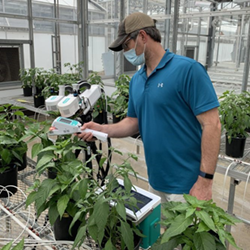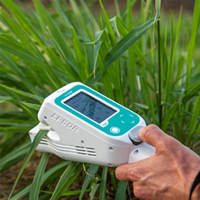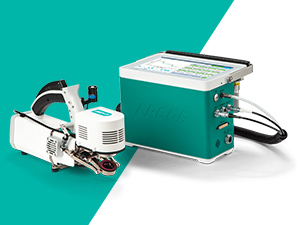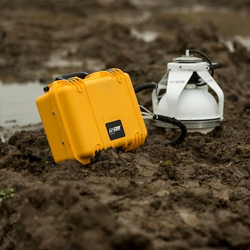
|
JULY NEWSLETTER
Highlights from the July issue:
- Using the LI-600 and LI-6800 for complementary leaf physiology measurements
- Measuring CO2 exchange and chlorophyll fluorescence on microalgae in solution
- Comparing the effect of leaf orientation on evergreen plants in Italy
- Connecting water table depth and greenhouse gas emissions with CO2 and CH4 flux data
- Upgrading your LI-6800 digital board for instantaneous response
- Monitoring soil gas flux to learn how biochar and lime affect maize yield
- Gathering CH4 emission data via aircraft and mobile measurement system near Seoul
- Applying carbon flux monitoring to decisions about peatland use in New Zealand
- Providing robust long-term EC data at three towers in Malaysia
Use the LI-600 and LI-6800 for complementary leaf physiology measurements
The LI-6800 Portable Photosynthesis System and the LI-600 Porometer/Fluorometer may have distinct purposes, but the data they provide is highly complementary. By using the two instruments together, you can quickly collect large data sets and explore physiological traits in more detail.
Check out a case study in which more than 500 pepper plant leaves were measured in a single day using an LI-600.
|
|
|
|
|
 |
Complementary instruments
Find out how data from a
high-volume survey with the
LI-600 were used to identify
individuals that were
evaluated in detail with the LI-6800.
See the Data
|
|
|
New paper: CO2 exchange and chlorophyll
fluorescence on microalgae in solution
A paper published in Algal Research this month investigates carbon uptake capacity and chlorophyll a fluorescence dynamics in three different strains of microalgae using the LI-COR 6800-18 Aquatic Chamber.
Authors Jason Hupp, Johnathon McCoy, both of LI-COR; Dr. Allan Milligan of Oregon State University; and Dr. Graham Peers of Colorado State University used the instrument to measure CO2 exchange from an aqueous solution of suspended cells at the same time that they examined chlorophyll fluorescence.
Check out the open-access paper to learn more about taking photosynthesis measurements in aqueous solutions.
|
|
Read the Paper
Comparing the effect of leaf orientation on evergreen plants in Italy
See how Professor Paolo De Angelis examined evergreen species in the Botanical Garden “Angelo Rambelli” in the province of Viterbo, Italy, to verify the operational and functional features of the LI-600 Porometer/Fluorometer.
“The ability to concurrently measure the main environmental drivers (light, VPD) and related fluxes gives an extremely comprehensive dataset.”
- Professor Paolo De Angelis
Read the Story
|
 |
Test out the LI-600 on your plants.
See for yourself why researchers are loving the LI-600. Enter for the opportunity to field test the instrument for one week.
Sign Up Now
|
|
Get instantaneous touch screen response on the LI-6800 with upgraded processor
When he first used the LI-6800 Portable Photosynthesis System in 2016, Randy Long of the University of California in Santa Barbara called it “a joy to use.” He said his two favorite features of the instrument were its speed and its user interface. Since 2016, the capabilities of the LI-6800 have expanded into applications including soil gas flux, insect respiration, and aquatic measurements.
Continuing this trend of innovation, the LI-6800 now includes a Quad Core Plus processor in all new LI-6800s. The new board is available as an upgrade for all instruments purchased from 2016 until Spring 2021. The processor replaces a single-core processor and allows the instrument’s touch screen to respond instantly, giving you faster access to your measurements.
|
|
|
|
|
|
|
|
Contact us for more information about the Portable Photosynthesis System or for details about upgrading your LI-6800.
|
 |
|
Email US
|
|
Study: CO2 and CH4 flux data connects water table depth and greenhouse gas emissions
Professor Christopher Evans and associates have published new research in an April edition of Nature describing how peatland water table depth could be key for reducing greenhouse gas emissions. While efforts to curb emissions from drained peatland usually mean conserving existing peatlands or re-wetting systems drained for agriculture or plantation development, Evans’ group concludes that emissions from peatlands used for agriculture could be reduced without halting their productivity by raising the water table depth.
Find out more about how the group used a LI-COR eddy covariance system for CO2 data and automated LI-8100A Soil Gas Flux system for CH4 data to conduct research at 41 locations across the UK and Ireland.
|
|
|
|
Read the Paper
|
|
Publication: Soil gas flux project examines how biochar and lime affect maize yield
Results of a study on the effects of biochar and lime on maize yield suggest that combining distinct types of biochar for soil amendment could increase crop performance, although the desired effects could be short-lived.
The research, published in Agriculture, specifically examined rice husk biochar and oil palm empty fruit bunches biochar in combination with lime. The authors, all from research institutions in Malaysia and Bangladesh, used the LI-COR LI-8100A Automated Soil Gas Flux System for their research project.
|
Test out the LI-600 on your plants.
See for yourself why researchers are loving the LI-600. Enter for the opportunity to field test the instrument for one week.
Read the Paper
|
 |
|
|
|
Gathering CH4 emission data via aircraft and mobile measurement system near Seoul
A paper published online in June by the Asia-Pacific Journal of Atmospheric Sciences provides data for methane levels outside metropolitan areas using aircraft and mobile platforms.
The research group, all from the Republic of Korea, identified methane concentration hotspots associated with intensive farming, industrial complexes, and waste dumps. With their observations, the authors note that hidden methane emission sources were excluded from the inventory, which means that methane emissions could be underestimated. They conclude that more effort and budget should be applied to monitoring methane leaks with the goal of achieving carbon neutrality.
Check out how the group used the LI-850 CO2/H2O Analyzer and the LI-7815 CO2/H2O Trace Gas Analyzer in their system for taking stationary and mobile measurements.
Read the Paper
|
|
Watch our two-part GHG emissions and concentrations webinar series
Cities are major sources of carbon emissions due to the concentration of human activities. Traditional methods of urban carbon emission estimates leave much to be desired because they are based on incomplete information, simplified models, or indirect measurements.
In this two-part webinar series, learn how you can take direct emissions measurements that provide real data leading to actionable insights for future zoning plans, investments, transportation decisions, regulations.
View the Recordings
|
|
Applying carbon flux monitoring to decisions about peatland use in New Zealand
A research station in New Zealand’s Kopuatai bog that has been continuously tracking carbon fluxes and water flows since 2011 is featured in New Zealand Geographic, along with breathtaking photos of the region’s waterscape. As the magazine reports, scientists from Waikato University have been monitoring the data for nearly a decade, trying to answer big questions about greenhouse gas emissions and land use.
"What do we do with land that’s being used, where it’s not fit for purpose? Because there are multiple consequences of that use—we need to have big pumping stations, we’re going to end up below sea level in some places, we’ve lost biodiversity and there are greenhouse-gas emissions. We need, as a society, to figure out whether that is what we want."
- PROFESSOR LOUIS SCHIPPER
Find out more about how the group is using measurements from their station, which includes the LI-COR LI-7500A Open Path CO2/H2O Gas Analyzer, to find solutions for drained peatland sites.
Check Out the Article
|
|
Providing robust long-term EC data at three towers in Malaysia
Three eddy covariance towers are being used by the Tropical Peat Research Institute (Tropi) in Sarawak, Malaysia, to study greenhouses gases and tropical peatland ecosystems.
With the economic importance of palm oil to the region, the group is particularly interested in sustainable land use in relation to climate change. According to Tropi director Dr. Lulie Melling, the Sarawak Eddy-Covariance Flux towers ensure continuous, robust, and long-term ecosystem measurements that offer insights for decision-making at all levels.
"These data-sets provide the understanding for crucial linkages between terrestrial ecosystem processes and climate-relevant responses at landscape, regional and continental scales."
- DR. LULIE MELLING
Learn more about the three Sarawak eddy covariance towers, which use the LI-COR LI-7700 Open Path CH4 Analyzer.
Read the Article
Updated software for your LI-COR instrument
Your LI-COR instrument will perform its best when you have the most updated available software installed. Find our most recent updates on our support website or by selecting a link below:
LI-7500A/RS Software
LI-7500DS Software
LI-7200/RS Software
LI-7810 Software
LI-7815 Software
LI-6800 Software
Be the first to know when the updated eddy covariance book is released
Dr. George Burba’s upcoming book Eddy Covariance Method for Scientific, Industrial, Agricultural, and Regulatory Applications will include the latest information on eddy covariance flux measurements. The free, updated edition features improved workflow descriptions and reviews of the latest developments.
Get a notification when the updated edition is released this summer!
Sign Up Now
Find us at upcoming conferences
Check out our booth at Botany 2021.
July 18-23 - Virtual
See LI-COR scientist Aaron Saathoff’s poster presentation at the Plant Biology Worldwide Summit
July 19-23 - Virtual
Register to receive LI-COR t-shirts for you and your lab at our 2021 ESA Annual Meeting booth.
August 2-6 - Virtual
Visit us at our ASHS Annual Conference booth to try out the LI-600 Porometer/Fluorometer.
August 5-9, 2021 - Denver, Colorado
|
|
Training
|
Photosynthesis Training
7-8 September
Online - Europe
21-23 September
Lincoln, Nebraska, USA
12-13 October
Lincoln, Nebraska, USA
16-17 November
Lincoln, Nebraska, USA
7-9 December
Lincoln, Nebraska, USA
|
|
Register
|
Eddy Covariance Training
14-16 September
Lincoln, Nebraska - USA
5-7 October
Online - Europe
|
|
Register
|